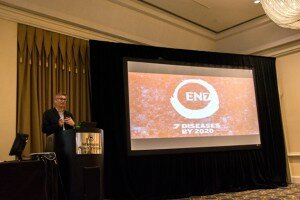
(L to R) Richard Hatzfeld, Sabin Vaccine Institute; David Harris, independent creative consultant; Elizabeth Bass, Alan Alda Center for Communicating Science
In a world where politics, ideology and values sometimes outweigh evidence, how can global health professionals better communicate what they do in order to achieve impact? Global Network’s Managing Director, Dr. Neeraj Mistry, addressed this question at last week’s American Society for Tropical Medicine and Hygiene (ASTMH) Annual Meeting. His panel discussion, titled “Using Communications to Elevate Neglected Tropical Diseases as a Policy Priority,” featured insights from Richard Hatzfeld, communications director for the Sabin Vaccine Institute; David Harris, an independent creative consultant who helped develop the ideas behind the END7 campaign; and Elizabeth Bass, director of the Alan Alda Center for Communicating Science.
 Elizabeth began by stressing the importance of knowing your audience and goals. While some stakeholders, including policy makers, may be familiar with your issue, it is important to understand where they are coming from so messaging can be adjusted accordingly. She also emphasized the importance of connecting with people. Each and every one of us has a unique background – whether we’re a cancer survivor, an animal lover, a mother or an athlete. If your audience knows more about who you are as a person, they are more likely to trust you and take what you say seriously, she said. Lastly, Elizabeth clued the audience in on what she sees as the “wonder drug” of communications: storytelling. While statistics can cause an audience’s eyes to glaze over, stories have the power to grab an audience’s interest, evoke emotion and make people care.
Elizabeth began by stressing the importance of knowing your audience and goals. While some stakeholders, including policy makers, may be familiar with your issue, it is important to understand where they are coming from so messaging can be adjusted accordingly. She also emphasized the importance of connecting with people. Each and every one of us has a unique background – whether we’re a cancer survivor, an animal lover, a mother or an athlete. If your audience knows more about who you are as a person, they are more likely to trust you and take what you say seriously, she said. Lastly, Elizabeth clued the audience in on what she sees as the “wonder drug” of communications: storytelling. While statistics can cause an audience’s eyes to glaze over, stories have the power to grab an audience’s interest, evoke emotion and make people care.
Further emphasizing the importance of storytelling, David Harris discussed creative communication campaigns that have worked. Every day, our brains are inundated with hundreds of advertising messages – so an engaging and creative story is necessary to stand out and cut through the noise. He first used the example of the Wise Child Trust – a largely unknown charity (at the time) that is working to end child trafficking. Through David’s innovative marketing campaign, happy and healthy school children in the UK were encouraged to write their own story about love, hope or friendship. These stories stood in stark contrast to the terrible stories of trafficked children. The stories of the school children were compiled into a book and were then sold to parents and the community –with all proceeds going towards Wise Child Trust. This campaign was hugely successful and used the power of storytelling to raise an unprecedented amount of awareness and funds for Wise Child Trust.

David also discussed the Global Network’s END7 campaign and its “How to Shock a Celebrity” video which has gained more than 600,000 views. The concept of “END7” has been effective, explained David, because of its specific and time-bound goal: End 7 neglected tropical diseases by 2020. The campaign’s tagline, “together we can see the end,” is inclusive and encourages everyone to be a part of the solution. In addition, he said, the campaign has a strong call to action – donate just 50 cents to treat and protect one child. was hugely successful and used the power of storytelling to raise an unprecedented amount of awareness and funds for Wise Child Trust.
 Next, Richard provided an overview of a communications campaign in India which will raise awareness of an upcoming mass drug administration for lymphatic filariasis (LF). He discussed the unique challenges of the campaign, which include messaging to diverse audiences, encouraging compliance and reaching media dark areas without access to television or radio. Richard emphasized that an effective communications campaign can overcome these issues and support the Indian government in their effort to eliminate LF by 2015.
Next, Richard provided an overview of a communications campaign in India which will raise awareness of an upcoming mass drug administration for lymphatic filariasis (LF). He discussed the unique challenges of the campaign, which include messaging to diverse audiences, encouraging compliance and reaching media dark areas without access to television or radio. Richard emphasized that an effective communications campaign can overcome these issues and support the Indian government in their effort to eliminate LF by 2015.
The remarks provided by Neeraj, Elizabeth, David and Richard drew needed attention to the importance of communications and storytelling in the field of global health. Through effective and smart communications, the global health community can have an even bigger impact on the world’s most vulnerable communities.
